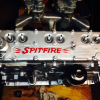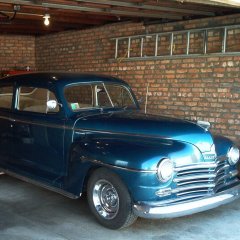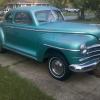
Dartgame
Members-
Posts
602 -
Joined
-
Last visited
-
Days Won
1
Dartgame last won the day on June 7 2023
Dartgame had the most liked content!
Reputation
160 ExcellentProfile Information
-
Gender
Male
-
Location
Chicago suburbs
-
Interests
Hard rock, all things mopar, home remodeling, live music, hot rods
-
My Project Cars
1952 plymouth business coupe
Contact Methods
-
Yahoo
ch50405@yahoo.com
-
Biography
been wrenching as a hobby since mid 70’s, restored two darts.
-
Occupation
retired from chemical/industry sales
Converted
-
Location
Suburban Chicago
-
Interests
Mopars, rock and roll, house remodeling
Recent Profile Visitors
2,823 profile views
-
I used 4 qts in my test, engine uses 5. My oil pan sump has baffles in it too. As I stated I will be using an O ring.
-
Finally getting the 230 assembled, its going well. Decided to investigate the position of the oil level vs the pivot on the oil pickup/pivot. With the oil pan leveled front to back & side to side; I poured 4 qts of water into the pan sump. I accounted for the up pipe thread-into the block and checked the position of the pickup pivot. The pivot point is completely submerged by 1 to 1.5 inches. So the main advantage I see to using an O ring on the pivot is to control the oil being picked up through the strainer. I'll do the O ring mod, with this in mind.
-
Just an fyi - the muscle era v8 stats fit in my 52 and work fine. Maybe for yours as well. Easy to check at a parts store. I like the robertshaw style stats, vs the cheapo's the big box stores sell.
-
what I've used for square drive plugs is some square key stock from the hardware. Slip it into the 12 point socket that fits it and away we go. works fine.
-
According to the mopar engines technical book, the bell housing bolt pattern is similar to the LA series (273, 318,340,360) motors, and will bolt up. There is supposed to be an offset difference on the crank flange. Meaning the position of the flange from the back of the block, so be sure to check that carefully. You may need an adapter to connect the transmission flywheel or torque converter. Or why not drop it in with the matching 904 or 727 trans ?
-
Thanks guys, Bests info is interesting. Maybe what I'll do is measure the cc's of an old copper gasket I have. I dont want to mess up the new fel pro I intend to use. I would imagine the fel pro being around .80 will compress similar to the best which gives about .052 installed, and .080 new. I'll report findings once I get them, probably in the next week.
-
Comparison of Dot 3,4,5 and DOT5.1 brake fluids
Dartgame replied to desoto1939's topic in P15-D24 Forum
something I've noted about DOT 5, is it can often be troublesome to get air bled out, and if you have a leaky fitting it won't "self seal" like the glycol based versions. By self seal I mean corrosion on the fittings if weeping a little. Moisture will corrode the offending parts with time and stop oozing....but I prefer the DOT5 for its non corrosive qualities. As mentioned above if a vehicle is left unused, nothing much changes in the brake system. -
Finally working on figuring out the compression ration for the 230 I'm building. I have two heads, one is from a (unknown year) 230 and the other is from a '53 218. I have a buret, and measured the cc's on each. Keep in mind that the 230 head appears to have been milled a fair amount, and the 218 not much if any at all. The 230 head CC'd at 74.3 The 218 head CC'd at 82.0 My plan is to mill the 218 head. Reason being is that the 230 head is in absolutely atrocious condition, very rusty inside the water passages...awful. My question is about head gasket cc's. I had read that for the 25 inch motors the cc for the gasket is around 18.5 cc. I have not been able to locate info about the 23 inch motors gasket cc's, fel pro has no info. Would it make sense to think that the gasket cc's are similar or the same ?
-
Dodgeb4ya - that's an interesting piece of information. I'll do some measuring and check the oil level vs pivot on the pickup. However, I wont be doing that until I get the block back and ready for assembly (probably several months). I'll report back once I know something more.
-
Thanks. I figured that was a weak point in the pickup, that could lead to low oil pressure. I found it interesting that someone had done this. Thanks for the link. I'm going to look into getting a neoprene o ring of the correct size, vs one of an unknown composition.
-
I'm in the process of cleaning parts and so on for a new 230 build I'll be assembling in the near future. What I am doing is using the internals from a rebuilt unused 230 that was intended for fork lifts. The machine work etc is excellent but the block should never have been used. The water jackets are something akin to the titanic. The water distribution tube was a complete disaster, they left part of an old one in the block, shortened a new one and pounded it in. I got that stuff out and discovered that the block is cracked between one of the cylinder head bolt holes and a water passage. Fortunately, I have a donor standard bore 218 block, which is getting all the internals etc from the 230. On to my question - the 230 oil pick up is interesting, because whoever built it, put a rubber O ring at the joint where the pick up pivots from the "up" pipe. I've never seen this before in the three other flatties I've had apart. What's the communities opinion about something like this? The o ring appears to be a standard rubber composition. I'm concerned it might degrade in hot oil.
-
You might consider taking the box to a radiator shop and explain what you want. They should be able to make or adapt something?
-
If not mentioned before, drain the coolant from the block, there is either a pet cock or a drain plug near that freeze plug.
-
You might want to take a look at evaporust. I've been using it to clean engine tins and hardware, works pretty good and washes with soapy water, and then blow dry.
-
I have been looking at zinc (ZDDP) levels in conventional motor oils and found several brands are making them for use with flat tappet engines like ours and most older v8s. Valvoline VR1 - 10w30, 20w50, 30 weight etc. seems to be readily available and contains what appears to be the correct ZDDP level. Pricing is around 35-40$ for 6 quarts. I figure why not use it, how many times do you change your oil ? Its probably not critical to have the "right" amount of ZDDP with a flat head due to the low valve spring pressures these engines use, but what the heck.





